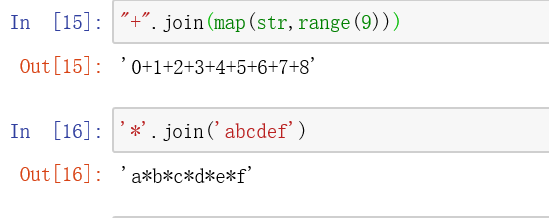1、字符串定义:
1>一个个字符组成的有序的序列,是字符的集合,是可迭代对象,可索引
2>使用单引号、双引号、三引号引住的字符序列,r前缀,f前缀
3>字符串是不可变对象
4>Python3起,字符串就是Unicode类型
# -*- coding:utf-8 -*- # version:python3.7 s1 = 'hello' for i in s1: #可迭代 print(i)
print("索引值为1的元素:",s1[1]) #可索引 执行结果: h e l l o
索引值为1的元素: e
s2 = 'hello beijing' # :换行符 print('s2:',s2) s3 = r'hello beijing' #r前缀:转义 ,当字符串输出 print('s3:',s3) s4 = 'ni'
s5 = 'hao'
s6 = "{s4} -> {s5}"
print('s6:',s6)
s7 = f"{s4} -> {s5}" #f前缀:引用
print('s7:',s7)
执行结果: s2: hello beijing s3: hello beijing
s6: {s4} -> {s5}
s7: ni -> hao
2、join连接字符串:
将可迭代对象连接起来,使用string作为分隔符
可迭代对象本身元素都是字符串
返回一个新的字符串
Signature: str.join(self, iterable, /) Docstring: Concatenate any number of strings. The string whose method is called is inserted in between each given string. The result is returned as a new string. Example: '.'.join(['ab', 'pq', 'rs']) -> 'ab.pq.rs' Type: method_descriptor
在可交互式python操作(如:jupyter)中可看到,join会立即返回返回一个新的字符串

在PyCharm中可以使用print()输出
# -*- coding:utf-8 -*- # version:python3.7 print('+'.join(map(str,range(10)))) #map函数:映射,把一个个数字转换成str print(' '.join(map(str,range(10)))) 执行结果: 0+1+2+3+4+5+6+7+8+9 0 1 2 3 4 5 6 7 8 9
3、+ → str
将两个字符串连接在一起,返回一个新字符串
# -*- coding:utf-8 -*- # version:python3.7 s1 = 'hello' s2 = 'world' print(s1 + s2) #字符串不可变,字符串相加产生新字符串 s3 = s1 + s2 s3 += s2 #等价:s3 = s3 + s2 print(s3) 执行结果: helloworld helloworldworld
4、字符串分割
分割字符串的方法分为2类
1>split
将字符串按照分隔符分割成若干字符串,并返回列表
rsplit(sep=None,maxsplit=-1) → list of strings
从右向左切割
sep指定分割字符串,缺省的情况下空白字符串作为分隔符
maxsplit指定分割次数,-1表示遍历整个字符串
# -*- coding:utf-8 -*- # version:python3.7 s1 = 'a,b,c,d,e,f' print(s1.split()) #默认使用空白字符分割,立即返回一个列表 print(s1.split(',')) #以','分割 print(s1.split(',',maxsplit=2)) #指定分割次数2次 print(s1.split(',',maxsplit=-1)) #maxsplit=-1,遍历整个字符串,相当于不指定maxsplit print(s1.rsplit(',',maxsplit=2)) #从右向左切 执行结果: ['a,b,c,d,e,f'] ['a', 'b', 'c', 'd', 'e', 'f'] ['a', 'b', 'c,d,e,f'] ['a', 'b', 'c', 'd', 'e', 'f'] ['a,b,c,d', 'e', 'f']
splitlines([keepends]) → list of strings
按行来切割字符串
keepends指的是是否保留行分割符
行分割包括
、
、
等
# -*- coding:utf-8 -*- # version:python3.7 s1 = 'I am super man' print(s1.splitlines()) #以换行符切割 print(s1.splitlines(True)) #保留换行符字符 print(s1.splitlines(False)) #不保留换行符字符,默认就是 执行结果: ['I', ' am', ' super', ' man'] ['I ', ' am ', ' super ', ' man'] ['I', ' am', ' super', ' man']
2>partition系
将字符串按照分隔符分割成2段,返回这2段和分隔符的元组
partition(sep) → (head, sep, tail)
从左至右,遇到分隔符就把字符串分割成两部分,返回头、分隔符、尾三部分的三元组;如果没有找到分隔符,就返回头、2个空元素的三元组
sep分割字符串,必须指定
# -*- coding:utf-8 -*- # version:python3.7 s1 = 'a,b,c,d,e,f' print(s1.partition(',')) #立即返回一个三元组,切一刀 split(maxsplit=1) print(s1.rpartition(',')) #从右向左切 print(s1.partition('c,d')) #以'c,d'切割 print(s1.split('c,d')) #split与partition的差别 执行结果: ('a', ',', 'b,c,d,e,f') ('a,b,c,d,e', ',', 'f') ('a,b,', 'c,d', ',e,f') ['a,b,', ',e,f']
5、大小写
upper()
全大写
lower()
全小写
大小写,做判断的时候用
swapcase()
交换大小写
# -*- coding:utf-8 -*- # version:python3.7 print('aBcD' == 'abcd') #不相等,返回False print('aBcD'.lower() == 'abcd') #将'aBcD'转换为全小写比较 print('abCD'.upper() == 'ABCD') #将'abCD'转换为全大写比较 print('ABcd'.swapcase()) #将大写转换为小写,将小写转换为大写 执行结果: False True True abCD
6、字符串编排
title() → str
标题的每个单词都大写
capitalize() → str
首个单词大写
center(width[, fillchar]) → str
width打印宽度
fillchar填充的字符
zfill(width) → str
width打印宽度,居右,左边用0填充
ljust(width[, fllchar]) → str左对齐
rjust(width[, fillchar]) → str右对齐
中文用的少,了解一下
# -*- coding:utf-8 -*- # version:python3.7 s1 = 'i am super man' print(s1.title()) #首字母大写 print(s1.capitalize()) #首单词大写 print(s1.center(30,'#')) #居中 print(s1.zfill(30)) #居右,左边用0填充 print(s1.ljust(30,'0')) #居左 print(s1.rjust(30,'0')) #居右 执行结果: I Am Super Man I am super man ########i am super man######## 0000000000000000i am super man i am super man0000000000000000 0000000000000000i am super man
7、字符串修改
replace(old, new[, count]) → str
字符串中找到匹配替换为新子串,返回新字符串
count表示替换几次,不指定就是全部替换
# -*- coding:utf-8 -*- # version:python3.7 s1 = '1 2 2 2 3 3 4 5' print(s1.replace('2','22')) print(s1.replace('2','22',1)) 执行结果: 1 22 22 22 3 3 4 5 1 22 2 2 3 3 4 5
strip([chars]) → str
从字符串两端去除指定的字符集chars中的所有字符
如果chars没有指定,去除两端的空白字符
lstrip 从左开始
rstrip 从右开始
# -*- coding:utf-8 -*- # version:python3.7 s1 = ' I am super man ' print(s1.strip()) #不指定,默认去除两边的空格 print(s1.strip(' Iamn')) #指定则从指定中匹配 执行结果: I am super man super
8、字符串查找
find(sub[, start[, end]) → int
在指定的区间[start, end),从左至右,查找子串sub。找到返回索引,没找到返回-1
rfind(sub[, start[, end]]) → int
在指定的区间[start, end),从右至左,查找子串sub。找到返回索引,没找到返回-1
# -*- coding:utf-8 -*- # version:python3.7 s1 = 'I am super man' print(s1.index('I')) #检索值返回结果,未检索到的话会报错 print(s1.find('s')) #检索值返回索引,未检索到返回-1 print(s1.find('A')) 执行结果: 0 5 -1
count(sub[, start[ end]) → int
在指定的区间[start, end),从左至右,统计子串sub出现的次数
时间复杂度
index和count方法都是O(n)
随着列表数据规模的增大,而效率下降
len(string)
返回字符串的长度,即字符的个数
9、字符串判断
endswith(suffix[, start[ end]]) -> bool
在指定的区间[start, end),字符串是否是suffix结尾
startswith(prefix[, start[ end]) -> bool
在指定的区间[start, end),字符串是否是prefix开头
# -*- coding:utf-8 -*- # version:python3.7 s1 = 'xxx.tar.gz' print(s1.endswith('.gz')) #判断是否以.gz结尾 print(s1.endswith('.tar',0,-3)) #[0,-3) 判断.tar print(s1.startswith('xxx')) #判断是否以xxx开头 执行结果: True True True
10、字符串判断is系列
isalnum() → bool 是否是字母和数字组成 isalpha() 是否是字母 isdecimal() 是否只包含十进制数字 isdigit() 是否全部数字(0~9) isidentifier() 是标识符嘛,字母和下划线开头,其他都是字母、数字、下划线 islower() 是否都是小写 isupper() 是否全部大写 isspace() 是否只包含空白字符
# -*- coding:utf-8 -*- # version:python3.7 a = input('>>>') if a.isdigit(): #判断是否为数字 print('number') else: print('not number') 执行结果: >>>tr not number
11、字符串格式化
字符串的格式化是一种拼接字符串输出样式的手段,更灵活方便
join拼接只能使用分隔符,且要求被拼接的是可迭代对象且其元素是字符串
+拼接字符串还算方便,但是非字符串需要先转换为字符串才能拼接
在2.5版本之前,只能使用printf style风格的print输出,2.5版本之后建议使用format函数风格
1>printf-style formatting,来自于C语言的printf函数
格式要求:
占位符:使用%和格式字符组成,例如%s、%d(字符串、数字)等
s调用str(),r会调用repr()。所有对象都可以被这两个转换。
占位符中还可以插入修饰字符,例如%03d表示打印3个位置,不够前面补零
# C风格: # -*- coding:utf-8 -*- # version:python3.7 # -*- coding:utf-8 -*- # version:python3.7 print("My name is %s,I am %d" % ('zhang',20)) #格式:字符模板(格式化字符) % 字符;%s->str %d->digit print("I am %04d" % 20) #长度为4,多余位用0补齐 print("I am %-4d" % 20) #长度为4,"-"负号表示左对齐,默认右对齐 print("%f" % 32.2456) #%f:浮点数,默认小数点后保留6位 print("%14.2f" % 32.2456) #长度为14位,精度为2(小数点后保留2位) print("%x" % 127) #%x表示十六进制,X表示大写 print("%#X" % 127) #"#"号表示0X前缀 执行结果: My name is zhang,I am 20 I am 0020 I am 20 32.245600 32.25 7f 0X7F
2>format % values,格式字符串和被格式的值之间使用%分隔
values只能是一个对象,或是一个与格式字符串占位符数目相等的元组,或一个字典
format函数格式字符串语法——Python鼓励使用
"{} {xxx}".format(*args, **kwargs) → str
args是可变位置参数,是一一个元组
kwargs是可变关键字参数,是一一个字典
花括号{}表示占位符
{}表示按照顺序匹配位置参数,{n}表示取位置参数索引为n的值
{xxx}表示在关键字参数中搜索名称一致的
{{}}表示打印花括号
# -*- coding:utf-8 -*- # version:python3.7 #不常用,了解即可,通常不定义前面占位符,不写死,一般在位置参数处定义 print("{} {}".format(1,2,3)) #允许后面超位 print("{2[0]} {1} {0}".format('a','b',['c'])) #支持索引,索引和位置对应不能混用,否则会报错 print("{name} {0} {1}".format('127.0.0.1',80,name='My server name is super PC')) 执行结果: 1 2 c b a My server name is super PC 127.0.0.1 80
# 进制
# -*- coding:utf-8 -*- # version:python3.7
print("{:#02x}{:02x}{:02x}{:02x}".format(127,100,10,20)) #02表示宽度为2,不够用0补,用16进制表示ip地址 print("int:{0:d}; hex:{0:x}; oct:{0:o}; bin:{0:b}".format(42))
print("int:{0:d}; hex:{0:#x}; oct:{0:#o}; bin:{0:#b}".format(42))
执行结果: 0x7f640a14
int:42; hex:2a; oct:52; bin:101010
int:42; hex:0x2a; oct:0o52; bin:0b101010
# 对齐 # -*- coding:utf-8 -*- # version:python3.7 print("{}*{}={:02}".format(2,3,2*3)) #长度为2,默认右对齐,不够用0补 print("{}*{}={:<2}".format(2,3,2*3)) #长度为2,左对齐 print("{}*{}={:#^20}".format(2,3,2*3)) #长度为20,居中,用"#"号填充 执行结果: 2*3=06 2*3=6 2*3=#########6##########
# 时间格式 # -*- coding:utf-8 -*- # version:python3.7 import datetime #模块 d = datetime.datetime.now() print(d) print("{:%Y-%m-%d %H:%M:%S}".format(d)) #冒号":",前面表示位置对应,0省略 执行结果: 2020-03-20 19:03:04.315352 2020-03-20 19:03:04
# 浮点数 # -*- coding:utf-8 -*- # version:python3.7 print("{}".format(3**0.5)) #1.7320508075688772 print("{:f}".format(3**0.5)) #1.732051 f:浮点数,精度默认为6 print("{:10f}".format(3**0.5)) #右对齐,宽度为10 print("{:3f}".format(3**0.5)) #注意:宽度可以被撑破,前面定义宽度为3,结果宽度大于3 print("{:.2}".format(3**0.5)) #1.7 2个数字,科学记数法 print("{:.2f}".format(3**0.5)) #1.73 小数点后2位 print("{:3.2f}".format(3**0.5)) #1.73 宽度为3,小数点后2位 print("{:20.3f}".format(0.2745)) #0.275 默认右对齐 print("{:3.3%}".format(1/3)) #33.333% 执行结果: 1.7320508075688772 1.732051 1.732051 1.732051 1.7 1.73 1.73 0.275 33.333%
建议使用format函数格式化字符串